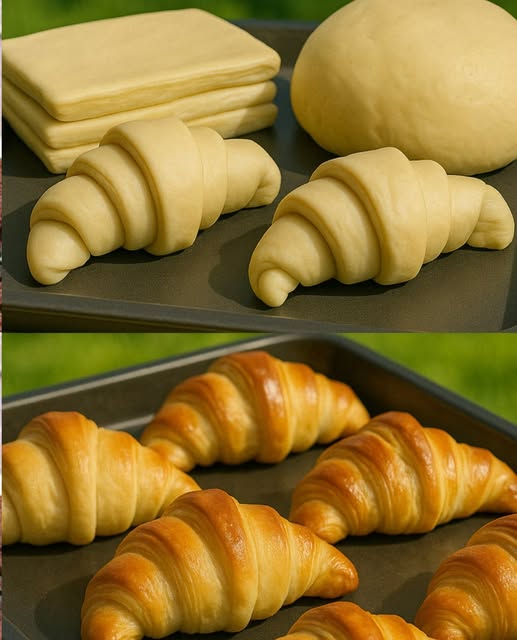Introduction
Few pastries embody the art of baking as perfectly as the flaky homemade croissant. With their golden, crisp exterior and hundreds of delicate, buttery layers within, croissants represent the pinnacle of laminated dough mastery. While the process requires patience and precision, the reward of pulling apart warm, fragrant layers you created yourself is unparalleled. This recipe guides you through every critical step—from yeast activation to the final bake—to achieve bakery-quality results in your own kitchen.
Unlike quick breads or standard pastries, croissants demand a meticulous folding technique called laminating, where butter gets enveloped in dough and repeatedly folded to create those signature flaky strata. The transformation of simple ingredients—flour, butter, yeast, and milk—into these luxurious pastries is nothing short of culinary alchemy. Perfect for special breakfasts, brunch gatherings, or as the ultimate baking challenge, homemade croissants will elevate your pastry skills and impress everyone fortunate enough to taste them.
Ingredients & Their Roles
Dough Base
- 1 cup warm milk (110°F/43°C) – Activates yeast and hydrates flour
- 2¼ tsp active dry yeast – Leavening agent for rise and flavor
- ¼ cup cane sugar – Feeds yeast and adds subtle sweetness
- 4 cups all-purpose flour – Structure (bread flour can substitute for chewiness)
- 1 tsp salt – Flavor enhancer and gluten regulator
Lamination Butter
- 1 cup (2 sticks) cold unsalted butter – Creates flaky layers (European-style butter preferred)
Finishing
- 1 beaten egg – Egg wash for golden sheen
Step-by-Step Instructions
Day 1: Dough Preparation (1 hour active + overnight chill)
1. Activate the Yeast
- Warm milk to 110°F (43°C)—wrist-temperature, not hot
- Whisk in yeast and sugar, let sit 5-10 minutes until frothy
2. Make the Dough
- In a stand mixer with dough hook, combine flour and salt
- Add yeast mixture, mix on low until a shaggy dough forms (~2 minutes)
- Knead 5-7 minutes until smooth and elastic
- Shape into a ball, place in greased bowl, cover
- Let rise 1-1.5 hours until doubled
3. Prepare Butter Block
- Between parchment paper, pound cold butter into an 8×5-inch rectangle
- Chill 30 minutes while dough rises
4. Encase Butter (Lamination Begins)
- Roll dough into a 10×15-inch rectangle
- Place butter block in center, fold dough over like a letter
- Seal edges, wrap in plastic, refrigerate 30 minutes
5. First Fold (Turn)
- On floured surface, roll dough to 10×20 inches
- Fold in thirds (business letter style)
- Wrap, chill 1 hour
6. Second & Third Folds
Repeat rolling and folding 2 more times, chilling 1 hour between each
Final fold before overnight rest
Day 2: Shaping & Baking (3-4 hours)
1. Final Roll-Out
- Roll dough to 10×24 inches, ¼-inch thick
- Cut into long triangles (5-inch base, 10-inch height)
2. Shape Croissants
- Stretch triangles slightly, roll from base to tip
- Curve into crescents, place on parchment-lined sheets
- Cover, proof 2-3 hours at 75°F (24°C) until jiggly and doubled
3. Bake to Perfection
- Preheat oven to 400°F (200°C)
- Brush with egg wash
- Bake 15 minutes, then reduce to 375°F (190°C)
- Bake 10-15 more minutes until deep golden
- Cool on rack 15 minutes
Expert Techniques
✔ Temperature Control: Keep dough cold (60°F/15°C) during lamination
✔ Even Rolling: Maintain rectangular shape for uniform layers
✔ Proofing Test: Croissants should feel air-filled, not dense
✔ Steam Boost: Place ice cube in oven during first 5 minutes
Troubleshooting Guide
| Issue | Cause | Solution |
|---|---|---|
| Butter leaks | Dough too warm | Chill longer between folds |
| Dense layers | Under-proofed | Extend proofing time |
| Pale color | Weak egg wash | Add 1 tsp water to egg |
| Uneven rise | Inconsistent thickness | Measure with ruler |
Serving & Storage
Best Enjoyed
- Fresh from oven (let rest 10 minutes)
- Rewarmed in 300°F (150°C) oven for 5 minutes
Preservation
- Room temp: 1 day in paper bag
- Freeze: Unbaked shaped croissants up to 1 month
- Reheat frozen: Bake at 350°F (175°C) for 15 minutes
Why This Recipe Works
The magic of proper croissants lies in:
- Lamination Science: 81 layers created through folds (3×3×3)
- Yeast Development: Slow fermentation enhances flavor
- Butter Quality: High-fat (82%+) European butter outperforms
Conclusion
Mastering flaky homemade croissants is a rite of passage for serious bakers. While the process spans two days, most is inactive chilling time. The reward—crisp, shattering exteriors giving way to honeycombed, buttery interiors—justifies every minute. This recipe demystifies the technique, breaking it into manageable steps with professional tips for success.
Beyond the pastry itself, the skills gained—temperature control, precise rolling, and patience—translate to superior puff pastry, danishes, and other laminated doughs. Whether you seek weekend baking projects or dream of Parisian breakfasts at home, these croissants deliver. Their ethereal texture and rich flavor will make store-bought versions pale in comparison, proving that with care and quality ingredients, home bakers can rival the finest patisseries.
